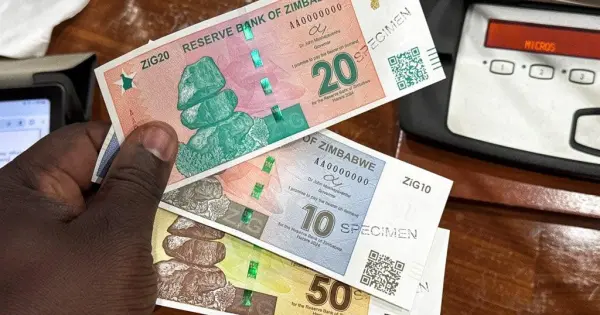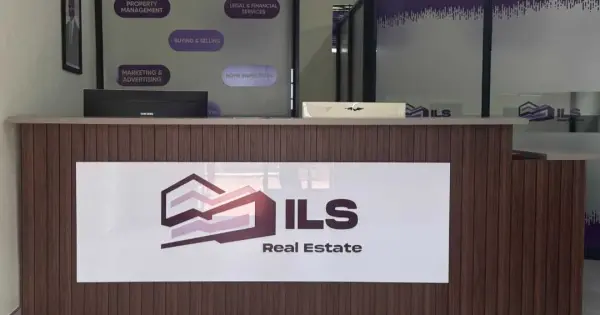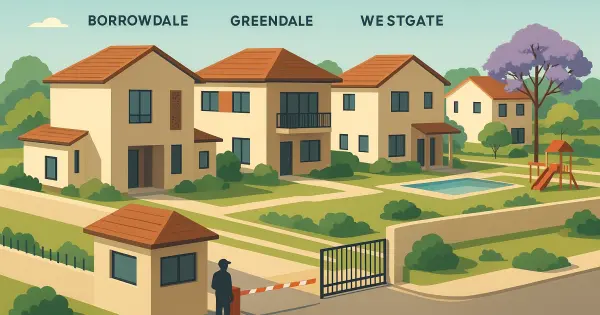Property types in Zimbabwe's market have multiplied over the past few years. Each comes with different price points, ownership rules, and profit potential that aren't always clear upfront.
This comprehensive analysis is designed for both first-time buyers and seasoned investors looking to understand Zimbabwe's property landscape in 2025.
The simple answer: Houses dominate Zimbabwe's market at 34% of all listings, averaging $235,000, while commercial properties offer higher returns at $775,000 average pricing. Whether you're looking to rent home options or purchase houses to live in permanently, the real opportunity lies in understanding which property type aligns with your budget, goals, and risk tolerance.
Zimbabwe's property market has shifted dramatically since 2024. New construction now represents 43% of available properties, with digital marketing driving 60% of successful sales. Currency stability has improved investor confidence, while infrastructure development in suburban areas is creating new opportunities outside traditional city centers.
As Zimbabwe's largest real estate platform with over 8,000 active listings across 80 cities and towns, Propertybook works with registered real estates agents in Zimbabwe to process data from 2,000+ agents and 100+ agencies. Our analysis reveals that property yields currently range from 5-7%, with suburban developments showing the strongest growth potential.
This article breaks down each major property category, compares investment returns, examines maintenance requirements, and provides actionable insights for your next property decision.
Understanding Zimbabwe's Property Market Structure
Zimbabwe's property market operates differently from many international markets. The foundation rests on four primary categories that serve distinct purposes and investor profiles.
Residential Properties form the backbone of the market. Houses account for roughly 3,500 properties nationally, representing the largest single category. These range from modest 2-bedroom homes in emerging suburbs to luxury 5+ bedroom estates in established neighbourhoods like Borrowdale and Mount Pleasant.
Commercial Properties occupy a smaller but lucrative segment. With only 300-400 active listings, commercial real estate commands premium prices averaging $775,000. This scarcity creates opportunities for investors with substantial capital and long-term strategies.
Residential Land represents pure development potential. These 1,500 properties offer the flexibility to build custom homes or develop multiple units. Land prices vary dramatically based on location, with serviced plots in Harare commanding significantly higher prices than rural agricultural land.
Specialized Properties include agricultural land, industrial facilities, and mixed-use developments. Agricultural land averages $415,000, reflecting Zimbabwe's agricultural heritage and ongoing land reform dynamics.
The market concentration tells an important story. Harare accounts for 60% of all property transactions, creating intense competition in the capital while leaving opportunities in secondary cities like Bulawayo, Mutare, and Gweru.
Ready to explore specific investment opportunities? Browse our complete property listings to see current market availability.
Residential Property Analysis: New Houses to Rent vs Purchase Options
Houses deliver the strongest market performance across multiple metrics. The average house price of $235,000 reflects steady demand from families seeking space, security, and long-term stability. Three-bedroom houses average $160,000, making them accessible to middle-income buyers, while 4 bedroom townhouse to rent options typically command an average of $2,400 monthly in premium suburbs like Borrowdale.
Houses offer several advantages that apartments cannot match. Private yards provide space for gardens, entertainment, and future expansion. Parking is rarely an issue, with most houses including covered garages or carports. Security concerns, a primary consideration for many buyers, can be addressed through high walls, electric fencing, and private security systems.
However, houses require more maintenance. You'll handle everything from roof repairs to garden upkeep. Property taxes tend to be higher, and utility costs increase with larger spaces. Location becomes critical – luxury houses for sale in Borrowdale, for example command prices averaging $1,100,000, while similar properties in developing areas might cost $150,000. For those seeking immediate income, a house up for rent in these established areas can generate substantial monthly returns.
Apartments to rent average $150,000 for purchase, making them attractive entry points for first-time buyers and investors targeting rental income. Modern apartment complexes in areas like Sam Levy's Village offer amenities like pools, gyms, and 24-hour security that individual houses rarely provide. For renters, luxury apartments to rent in these developments typically cost $600-1,800 monthly depending on size and amenities.
Apartments excel in convenience. Maintenance responsibilities fall to building management, reducing your personal involvement. Location advantages are significant – most apartments cluster near shopping centers, schools, and business districts. This translates to shorter commutes and higher rental demand from young professionals. A 1 bedroom to rent in Hatfield typically commands $350-500 monthly, while 2 bed rental options in the same area range from $500-750.
The downside centers on space limitations and monthly levies. Most apartments range from 1-3 bedrooms, limiting family expansion. Body corporate fees typically run $50-150 monthly, adding to ownership costs. Parking can be limited, and noise from neighbors becomes a consideration. City centre flats face additional challenges with limited parking and higher security concerns.
Investment returns favor apartments in prime locations. A well-located apartment to rent in the city centre can generate 6-8% annual yields through rental income, while houses in similar areas might only achieve 4-6% yields due to higher purchase prices. Working with rental real estate agents helps optimize these returns through professional tenant management and market pricing strategies.
Commercial Property Investment Potential
Commercial properties represent Zimbabwe's highest-value property category, averaging $775,000 per transaction. This premium pricing reflects several factors that make commercial real estate attractive to serious investors.
Retail Spaces in established shopping centers like Sam Levy's Village and Borrowdale Village Walk command the highest prices. Ground-floor retail with street visibility can cost $1,200-1,500 per square meter, while upper-floor spaces trade for $800-1,000 per square meter. These properties benefit from established foot traffic and proven business environments.
Retail investments work best for investors who understand tenant management. Triple-net leases shift maintenance, insurance, and tax responsibilities to tenants, improving your cash flow predictability. However, vacancy periods can be costly, and economic downturns impact retail businesses first.
Office Buildings offer more stable income streams through longer lease terms. Professional tenants typically sign 2-5 year agreements, providing predictable cash flows. Modern office buildings in Harare's CBD achieve rental rates of $8-12 per square meter monthly, while suburban office parks command $5-8 per square meter.
Office properties require significant capital investment upfront. Building modifications for specific tenants, parking requirements, and technology infrastructure add to initial costs. However, established office buildings with quality tenants can deliver 7-10% annual returns.
Industrial Properties serve Zimbabwe's manufacturing and logistics sectors. Warehouse space averages $3-5 per square meter monthly, while specialized manufacturing facilities command higher rates. Industrial properties often require longer investment horizons but offer stable returns from established businesses.
Location drives commercial property success more than any other factor. Properties within 5 kilometers of Harare's CBD consistently outperform suburban alternatives. Access to major roads, proximity to banking centers, and availability of skilled workers all impact commercial property values.
Want to explore commercial opportunities in your area? Search commercial properties to see current market options.
Land Investment: Development Opportunities and Risks
Residential Land offers the purest development play in Zimbabwe's property market. These 1,500 properties range from small suburban plots to large estate developments, with prices varying dramatically based on location and infrastructure availability.
Serviced residential plots in established suburbs like Mount Pleasant or Highlands (which is more rare) cost $80-150 per square meter. These plots include water, electricity, and sewer connections, making them ready for immediate construction. The premium pricing reflects infrastructure investment and established neighborhood amenities.
Unserviced land in developing areas costs $20-50 per square meter but requires significant additional investment. You'll need to arrange water boreholes, electrical connections, and septic systems. While initial costs appear attractive, infrastructure development can double your total investment before construction begins.
Agricultural Land averaging $415,000 serves both commercial farming and residential development purposes. Large agricultural properties often include existing infrastructure like irrigation systems, farm buildings, and worker housing. These properties appeal to investors seeking agricultural income or long-term development opportunities. Many feature 4 bedroom farm houses for rent that can generate additional income while the land appreciates in value.
Agricultural land faces unique regulatory considerations. Zimbabwe's land reform policies continue evolving, creating uncertainty for some investors. However, properly documented agricultural properties with clear title deeds offer excellent long-term value, especially near growing urban centers.
Development Timing becomes critical for land investments. Properties purchased in developing areas like Arlington or Mount Hampden show strong appreciation potential as infrastructure expands. However, development timelines can extend 5-10 years, requiring patient capital and careful planning.
Land investments require more active management than other property types. You'll need to monitor development plans, infrastructure projects, and zoning changes that affect property values. Successful land investors often work with local developers, architects, and municipal planners to maximize development potential.
Market Trends Shaping Property Type Performance
Digital Marketing Dominance has transformed how different property types perform in today's market. Properties with professional photography, virtual tours, and social media promotion sell 30-40% faster than traditional listings. This trend particularly benefits apartments and commercial properties, where visual presentation significantly impacts buyer interest.
Modern buyers expect comprehensive online information before scheduling viewings. Properties lacking digital presence struggle to attract serious inquiries, regardless of pricing or location advantages. That is why platforms such as Propertybook are so beneficial.
Security Concerns continue driving residential property preferences. Gated communities in Harare and cluster developments command premium pricing due to enhanced security features. Individual houses require private security investments, while apartment complexes offer shared security costs. Zimbabwe luxury homes in secure estates often appreciate faster than similar properties without comprehensive security measures.
Security considerations affect long-term property values. Areas with improving security profiles see stronger appreciation, while neighbourhoods with security challenges face pricing pressure.
Infrastructure Development creates winners and losers across different property types. Suburban areas receiving new road connections, shopping centers, or industrial developments experience rapid property appreciation. Commercial properties benefit most from infrastructure improvements, as business accessibility directly impacts rental income.
Sustainable Building Practices are becoming market differentiators. Properties with solar power, rainwater harvesting, and energy-efficient designs attract premium buyers and tenants. These features reduce operating costs and appeal to environmentally conscious investors.
Green building features add 10-15% to construction costs but can increase property values by 20-25% in premium markets. This trend particularly benefits new construction and renovated properties.
Making Your Property Type Decision
Budget Alignment should drive your initial property type selection. If you have $150,000-250,000 available, focus on apartments or smaller houses in developing suburbs. These properties offer good appreciation potential with manageable maintenance requirements.
Investors with $300,000-500,000 can consider larger houses in established suburbs or small commercial properties. This budget range opens opportunities for higher rental yields and stronger long-term appreciation.
Investment Goals determine which property type serves your strategy best. Income-focused investors should prioritize apartments and commercial properties with established rental markets. Appreciation-focused investors might choose land or houses in rapidly developing areas.
Management Capacity affects property type suitability. If you prefer minimal involvement, apartments with professional management or commercial properties with triple-net leases work best. Hands-on investors might choose houses or land where active management can add significant value.
Market Timing influences property type performance differently. Economic uncertainty typically benefits residential properties over commercial real estate, as housing demand remains relatively stable. Economic growth periods favor commercial properties and land development opportunities.
The most successful property investors often diversify across multiple property types as their portfolios grow. Starting with one property type allows you to develop expertise before expanding into other categories.
Risk Tolerance varies significantly between property types. Houses and apartments offer relatively predictable returns with moderate appreciation potential. Commercial properties and land carry higher risks but offer greater upside potential for experienced investors.
Consider starting with residential properties to build market knowledge and cash flow, then gradually expanding into commercial or land investments as your experience and capital base grows.
Regional Market Variations Across Zimbabwe
Harare's Dominance shapes national property type performance. The capital city accounts for 60% of all property transactions, creating intense competition that drives prices above national averages. Commercial properties in Harare's CBD command premium pricing, while residential properties in suburbs like Borrowdale and Mount Pleasant set national price benchmarks.
Harare's market depth allows for more specialized property types. Luxury apartments, boutique office buildings, and mixed-use developments find ready markets in the capital. However, this sophistication comes with higher entry costs and more complex investment requirements.
Secondary Cities like Bulawayo, Mutare, and Gweru offer different investment dynamics. Property prices average 30-50% below Harare levels, creating opportunities for investors seeking higher yields or lower entry costs. However, market liquidity is reduced, meaning properties take longer to sell when you need to exit.
Commercial properties in secondary cities serve local markets rather than national businesses. This creates stability during economic downturns but limits growth potential during expansion periods.
Emerging Suburban Areas around major cities show the strongest growth potential across all property types. Areas like Norton, Chitungwiza, and Ruwa benefit from urban expansion while maintaining lower property prices. Infrastructure development in these areas often triggers rapid appreciation for early investors. New properties to rent in these developing suburbs attract tenants seeking affordable housing with easy access to urban centers.
Land investments perform particularly well in emerging suburban areas, as urban growth drives development demand. However, timing becomes critical – entering too early might require patient capital, while entering too late reduces appreciation potential. Houses to rent garden city and similar developing areas often provide the best balance of affordability and growth potential for new investors.
Rural and Agricultural Areas operate under different market dynamics entirely. Agricultural land serves dual purposes as farming operations and long-term development plays. Properties near major highways or urban centers show stronger appreciation than remote agricultural areas.
Rural property investments require specialized knowledge of agricultural markets, land use regulations, and infrastructure development plans. These investments often work best for investors with farming experience or long-term development strategies.
Understanding regional variations helps you identify opportunities that national averages might not reveal. The best property type for your situation might depend heavily on which region you're targeting for investment. Working with the list of registered real estate agents in Zimbabwe ensures you get professional guidance tailored to local market conditions and regulatory requirements.
Ready to explore regional opportunities and find luxury flats to rent or purchase options? Browse properties by location to compare options across Zimbabwe's markets.




